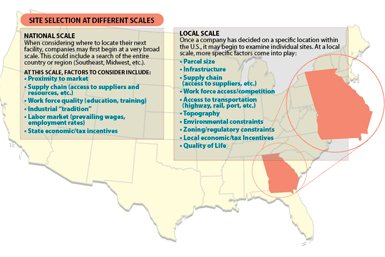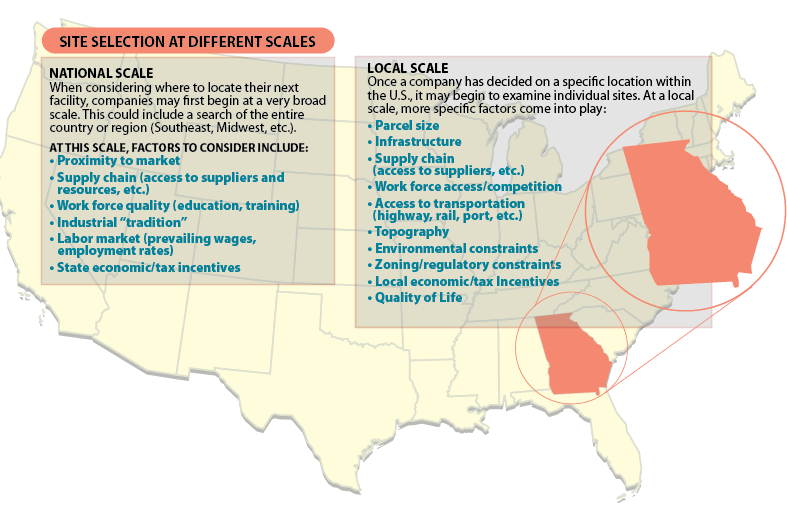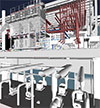In the Q4 2013 issue of Area Development, economic development leader Courtney Dunbar discussed why it is crucial to forego assumptions regarding site preparedness and perform due diligence. She noted that because site selection timelines are much shorter now than they used to be, important factors and site attributes such as incentives, zoning policies, and optimal tract size are often overlooked. The fact of the matter is that most organizations direct a great deal of effort toward site selection but still struggle to properly evaluate all possible considerations. The list of criteria to be reviewed is seemingly endless, and the traditional site selection process can sometimes be overwhelming.
Striking the Right Balance
Before a company can dig down into the specifics of certain site options, it must first decide on a region, state, and community to locate its operations. It has to consider access to the market (clients, partners, and suppliers), access to infrastructure, and the available labor pool. The company wants a skilled work force that is capable of upholding its product quality and reputation. But it must also consider the cost of labor and the competition for that labor. If the firm selects a city with an abundance of workers but also an abundance of other manufacturing employers, it has to constantly worry about staff that could potentially be hired away. It’s all about striking the right balance.
To help make these decisions, many large industrial companies opt to hire consultants associated with large global organizations that also provide accounting, legal, or real estate services. These groups have extensive resources available to help determine an optimal location. But small- to medium-sized companies often don’t have the ability to spend six figures on their next location decision, so they utilize a more focused and personalized organization to assist them.
James Blair represents one such organization; he’s the managing director for GACC South Services, LLC, a for-profit subsidiary of the German American Chamber of Commerce of the Southern United States, Inc., which provides customized site selection services for European and particularly German companies seeking to establish a manufacturing presence in the United States. Considering the difficulty that even an American company faces when it comes to site selection, it’s easy to see how a foreign or international company would feel daunted. The sheer size and scope of the U.S. means there are near limitless site options to consider, in both big cities and rural communities.


“As a site selector, I’m dependent on states and communities across the country to provide me with good, accurate information regarding the sites they have available, the qualifications of their available work force, tax rates, incentives, and so forth,” says Blair. “Of course, these states and communities are working hard to attract new business, so they make a point to offer up highly competitive data. My biggest challenge is verification of their information; I have to weed out the superfluous marketing statistics and zoom in on the essential figures. When I present site options to my clients, I want to make sure I’ve performed due diligence and corroborated all of the facts.”
Now more than ever, geographic information systems (GIS) - like Area Development’s www.FastGIS.biz - can maximize results by streamlining the site selection process described by Blair. GIS provides the ability to quickly and efficiently consider multiple layers of data simultaneously to make well-informed and objective site decisions. As a result, users don’t need to rely exclusively on data supplied by individual communities, which are often subjective and less robust. This allows companies to be more proactive in scouting out potential sites and may present options they’d have never thought of otherwise.
The once-arduous process of evaluating an entire country’s viable locations becomes more about objective data analysis and less about legwork. Users can prescribe very specific criteria for their site search. For instance, they can specify a site in a community where the work force is comprised of at least 25 percent manufacturing industry jobs but no more than 50 percent. They can specify a site that’s no more than 10 miles from a certain supplier or in a spot that’s no farther than a day’s drive from at least four clients. Much of this relevant data is readily available from public sources, such as the U.S. Census, Department of Labor, and local governments. Moreover, GIS applications even make it possible to prioritize or assign extra “weight” to certain categories. For example, a user wants to find a flat parcel in a community located close to a supplier, but feels that being located directly off the interstate is a non-negotiable; the analysis can be configured to assess data based on those priorities.
Selecting the Optimal Location
Once the data for all available sites is analyzed — using the criteria specified by the user — a list could be generated that ranks sites based on their “score” — basically, how well each site matches the criteria. The sites with the best scores represent a short list of the best options. From there, the location team can evaluate those options and use other resources to help select the optimal site from the short list. The point is that an advanced GIS approach is designed to objectively and comprehensively identify the best possible candidate locations for industrial companies in the quickest and easiest way.
As a site selection tool, there are limitless possibilities for GIS. The downside is that while some of the site selection data is readily available, certain information requires a more rigorous process of development. For that reason, it’s still important to work with a solid partner who has a good understanding of what important data might be missing. But as use of GIS becomes more widespread, the database of pre-existing information continues to grow. Its development and increased use means industrial companies are able to search for and evaluate sites more proactively, and thus are more likely to end up choosing the best possible location. It’s a fantastic way to save time and money, with the end result of improving long-term performance and growing the bottom line.
